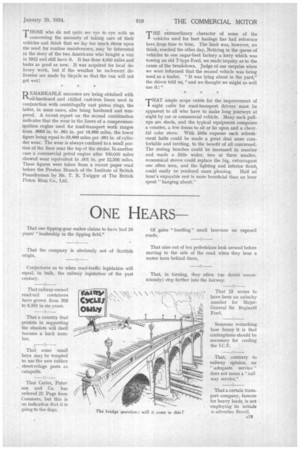Passing Comments
Page 28

Page 29

If you've noticed an error in this article please click here to report it so we can fix it.
THOSE who malign the bus, and in their efforts to decry its many advantages point to its contribution to road wear and tear, may, excusably, be reminded that another form of contribution by such vehicles is made annually in respect of Road Fund licences. As we take our penny bus ride and think of the distance we travel for it, let us not forget that big sums for the right to run are paid by operators. The largest is the amount paid by London Transport, its cheque for this year's licences being for £430,000. THE railway companies are well aware of the speed 1 limits on commercial vehicles when they are concerned with having road-transport operators prosecuted for breaches of those limits, but when the railways themselves are involved the case is altered. A railway employee was recently fined for exceeding the speed limit of 16 m.p.h. for " mechanical-horse " tractors and trailers, and the company submitted that if such a low limit were imposed the machines would become uneconomic and would have to be discarded ! THOSE who do not quite see eye to eye with us 1 concerning the necessity of taking care of their vehicles and think that we lay too much stress upon the need for routine maintenance, may be interested in the story of the two Americans who bought a van in 1912 and still have it. It has done 4,000 miles and looks as good as new. It was acquired for local delivery work, but if tho weather be inclement deliveries are made by bicycle so that the van will not get wet !
1EMARKABLE successes are being obtained with oil-hardened and chilled cast-iron liners used in conjunction with centrifugally cast piston rings, the latter, in some cases, also being hardened and tempered. A recent report on the second combination indicates that the wear in the liners of a compressionignition engine used for road-transport work ranges from .0003 in. to .001 in. per 10,000 miles, the lower figure being equal to 33,000 miles per .001 in. of cylinder wear. The wear is always confined to a small portion of the liner near the top of the stroke. In another case a commercial petrol engine after 100,000 miles showed wear equivalent to .001 in. per 12,500 miles. These figures were taken from a recent paper read before the Preston Branch of the Institute of British Foundrymen by Mr. T. R. Twigger of The British Piston Ring Co., Ltd. THE extraordinary character of some of the I vehicles used for beet haulage has had reference here from time to time. The limit was, however, we think, reached the other day. Noticing in the queue of vehicles to one sugar-beet factory a lorry which was towing an old T-type Ford, we made inquiry as to the cause of the breakdown. Judge of our surprise when we were informed that the second vehicle was being used as a trailer. "It was lying about in the yard," the driver told us, "and we thought we might as well use it!"
THAT ample scope exists for the improvement of 1 night cafés for road-transport drivers must be apparent to all who have to make long journeys at night by car or commercial vehicle. Many such pullups are sheds, and the typical equipment comprises a counter, a few forms to sit or lie upon and a cheerful coke stove. With little expense such refreshinent halts could be made a great deal more comfortable and inviting, to the benefit of all concerned. The resting benches could be increased in number and made a little wider, two or three smaller, economical stoves could replace the big, extravagant one often seen, and the lighting and interior finish could easily be rendered more pleasing. Half an hour's enjoyable rest is more beneficial than an hour spent "hanging about."




















































































